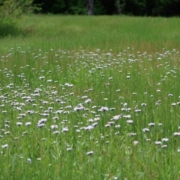No Mow
A guy who raised an orphaned beaver kit once reported that at a certain age the animal started dragging brooms and clothes and whatever else she could find to make little dams in every doorway of the cabin. You probably smiled as you read that and thought: what simple little robots. But think about it a little longer and the behavior might become uncomfortably recognizable. We humans are beaver-like, drawn by a similar unconscious, primordial desire to remake our ecosystems. Even us ecologically sensitive types are doers to a fault — we wake and immediately start cultivating and tending and building. Simple little robots with big brains that justify myopic internal cues.
The No Mow May movement encourages people to help wildlife – specifically pollinators – by letting their lawn grass grow. Our beaver-like human need to do is going to make it hard for the movement to catch on. But if you can get over that, what a pleasure it is to see blue and white violets appear, then yellow dandelions and pink fleabane and purple creeping Johnny and yellow wild strawberries and orange hawkweed and white and red clovers. Right now someone is calculating the economics and time it would take to rip up their grass and plant a pollinator garden, but there is already a pollinator garden within the grass just waiting to be let out. And the grass itself is stunning when it’s tall: the delicate panicles on the bluegrass and fescues, the thin colored spikelets on the foxtail and brome. You can watch the wind in this grass. Watch the insects hatch from it, drawing flycatching songbirds and endangered bats.
As fate would have it, the lawn I let grow out this year abuts a food plot I planted for wildlife two years back in a fallow strip before the woods. I spent hours resurrecting an old plow and a set of disks from the 1940s that I used to turn the earth. Lime applications preceded buckwheat cover crops that preceded two separate clover seedings (the first didn’t take); money spent on diesel and seed, not to mention big chunks of time. The clover’s fine – wild animals eat it sometimes. But what a lesson as I watched turkeys all spring long walk through the clover and into the overgrown lawn grass to feed and feel safe.

